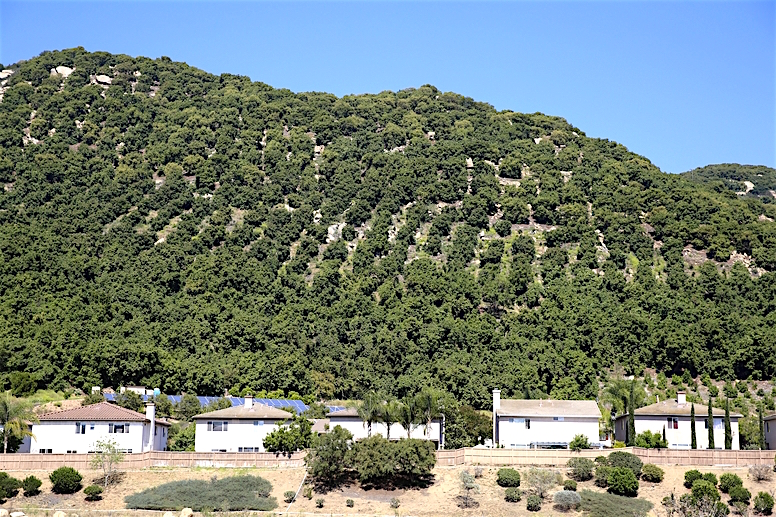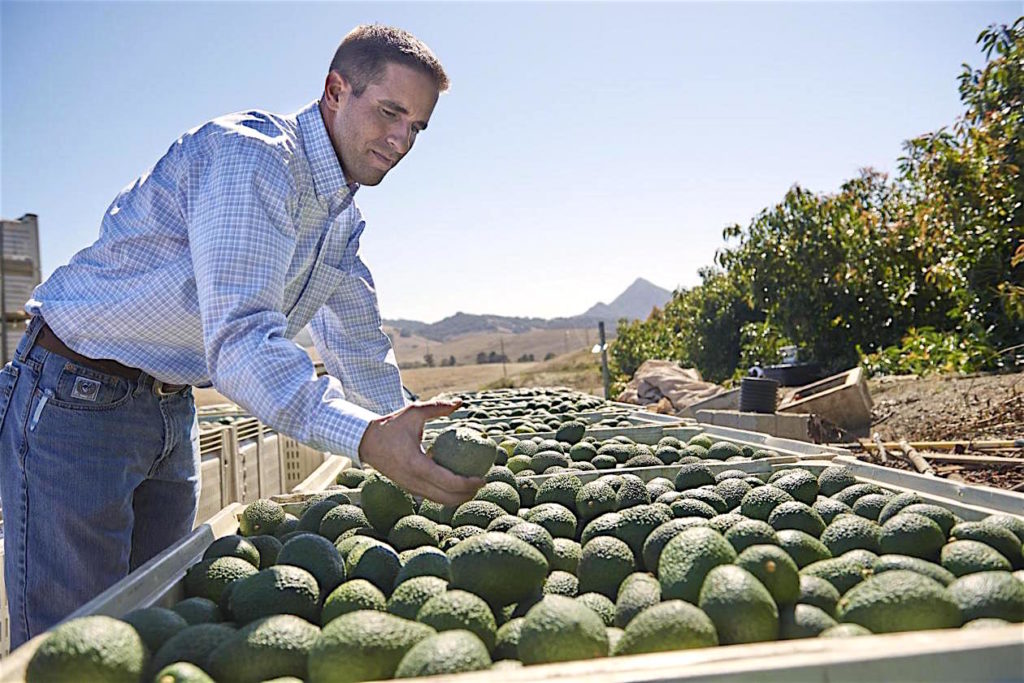Spanning the grove to bring you the constant variety of avocado news… the thrill of guacamole .. and the agony of spoiled fruit… the human drama of creating great avocado marketing…This is The Grapevine’s Wide World of Avocados!
— Escondido-based Henry Avocado expands to Charlotte, North Carolina
— Avocado importers weigh in on NAFTA
— Mexican avocado volume up
North County San Diego and Temecula account for one-third of all avocados grown in California. The state produces 95 percent of all avocados grown in the U.S.
Over the last 10 years, avocado acreage in the county has dwindled from around 30,000 acres to 18,000 acres. and expected to drop to 15,000 acres in the next two years. Total avocado crop value was nearly $198 million in 2013.
Henry Avocado with headquarters at 2355 E Lincoln Ave. was founded in 1925 by Charles and Florence Henry who were among the first growers to plant avocados in San Diego County. The original Henry farm has been in continuous production since then and serves as the company’s headquarters.
**********************************************************************************************
Henry Avocado opens distribution center at Charlotte, North Carolina

One of Escondido’s Henry Avocado Corp.’s far-flung distribution centers, this one in San Antonio, Texas/Courtesy
Escondido’s grand old avocado mega company Henry Avocado is n the march again.
Responding to the increasing demand for its ripening service and the anticipated surge in avocado supplies in 2018, and beyond, Henry opened a 25,000-square-foot distribution center this month at Charlotte, it’s first distribution center east of Houston, Texas, and seventh overall.
The new center is capable of custom-ripening over a million cartons a year, according to Ozzie Figueroa, Henry marketing and customer service director.
Carefully selected for its growing population, dynamic economy and vibrant restaurant and retail segments, Charlotte is a major transportation hub with the two major freeways — interstates 77 and 85 — passing through the city within 10 minutes of the new distribution center.
In addition, the facility design meets all food-safety standards featuring modern and efficient cold storage and nine forced-air ripening rooms to accommodate the anticipated demand. Henry has over 100 forced-air ripening rooms in its distribution centers located in four states.
“Our purpose,” said Figueroa, “is to consistently provide customers with superior quality, fresh avocados and service.”
Henry, which developed the ripening room concept more than three decades ago, has ripening and distribution centers in Escondido (two) and Milpitas, CA, and from the southwest in San Antonio and Houston, and Phoenix. The strategic location of Henry’s distribution centers have been the key to the company’s widely recognized customer service, which includes publishing a “Ripening Guide,” which assures the exact stage of ripeness each order requires.
The main source of product will be avocados from Mexico. To ensure year-round availability, however, avocados from California, Peru and Chile can supplement the supply during their respective seasons.
The Charlotte center enables Henry, which was founded in 1925, to offer its Bravocado and Green Goddess brands to additional customers in the eastern states. It is also now in position to better serve its growing customer base in retail and foodservice with avocados ripened to order.
Over the past 10 years, U.S. consumption of Hass avocados has been growing at approximately 9 percent per year. Growth last year was flat, however, as Mexico and California had smaller crops. Both countries’ production is projected to rebound with more volume, quality and price stability in 2018.
Expert industry sources anticipate at least a 10 percent increase in avocados from Mexico in 2018, and the California Avocado Commission expects production from its growers to double from 200 to 400 million pounds. This October’s weather in Peru has been mild and very conducive to a good crop-set for the 2018 harvest.
US avocado growers support NAFTA

May 19, 2016. I North County, CA. USA. | Avocados Groves in San Diego North County/Jamie Scott Lytle. Copyright.
As efforts to renegotiate the North American Free Trade Agreement plod along, avocado importers generally are supportive of the pact, though some feel it could use some tweaking.
“We believe it should remain as it is,” said Phil Henry, president of Henry Avocado Corp., Escondido, Calif.
“The relationship between Mexico and the U.S. has been very good and beneficial for everyone — for consumers, especially,” Henry said.
Mission Produce Inc., Oxnard, Calif., is one of 11 members of The Produce Coalition for NAFTA, said Robb Bertels, Mission’s vice president of sales and marketing,
The coalition issued a statement in which Steve Barnard, Mission’s president and CEO, pointed out that U.S. consumption of avocados has increased by nearly five times since the U.S. border opened to Mexican imports.
“Regardless of growing regions, it’s a win-win for everyone who has contributed to increasing demand driven by a consistent 12-month supply,” he said.
The agreement isn’t broken, Bertels said, “so it doesn’t really need to be fixed.”
Giovanni Cavaletto, vice president of sourcing for Index Fresh Inc., Riverside, Calif., said NAFTA, which took effect in 1994, has been “hugely beneficial,” but he added that anything that’s more than 20 years old might need some updating.
“It’s probably worth going back in and looking at some of the mechanics of the law,” he said. “A lot of things have changed.”
For example, he said the market has grown from 400 million pounds of avocados to 2.5 billion pounds, and e-commerce has become a common means of buying and selling the fruit.
“It’s been wonderful to watch the economic growth that all three countries have benefited from for the last 20 years,” he added.
The Washington, D.C.-based United Fresh Produce Association issued a statement saying that the NAFTA era has seen “important growth in the fruit and vegetable industry to meet consumer demand.”
But the statement added, “There are certainly specific challenges within fresh produce that NAFTA modernization can aggressively address, so we are pleased that this opportunity has been realized by the administration.”
Tom Nassif, president and CEO of Irvine, Calif.-based Western Growers said in a statement that to encourage enhanced competition, “We ask the Trump administration to work with our North American trading partners to further work on science-based standards, harmonize sanitary and phytosanitary standards and eliminate other non-tariff trade barriers.”
The next round of negotiations is set for Nov. 17-21 in Mexico City.
Mexican avocado volume up, up, up this year

California grower Gabe Filipe checks out avocados that will be marketed by Mission Produce Inc., Oxnard, Calif. “California’s quality has been really good this season,” says Robb Bertels, Mission’s vice president of sales and marketing. The Irvine-based California Avocado Commission expects 392 million pounds of avocados to be harvested this crop year — about 40% more than last year/Photo by Mission Produce Inc.
Avocado volume out of Mexico should reach nearly 2 billion pounds during the current season — July 1 to June 30 — an increase from last year, despite a slow start during the summer.
Volume could be 15% more than last year, said Rob Wedin, vice president of sales and marketing for Calavo Growers Inc., Santa Paula, California.
But since fruit size will be slightly smaller, the number of avocados actually could be 20% greater than last year, he said.
“We’re getting good supplies of 48s, which is a large fruit,” he said in mid-October.
Supplies of size 40s were OK, but there were few 36s and 32s.
“That indicates that growers are size picking,” he said, trying to pick 60s and larger and letting their size 70s and smaller grow.
He said prices might be 25% higher than two years ago as a result of the increasing popularity of avocados, and because growers are gaining confidence in the value of their crops.
Growers also are getting better at controlling inventory and communicating market conditions, Wedin said.
Calavo’s volume will be up more than 15% over last year, he estimated.
Despite relatively strong numbers, f.o.b. prices tumbled $20 to $30 per carton between mid-September and mid-October, said Bob Lucy, partner at Del Rey Avocado Co. Inc., Fallbrook, Calif.
“Prices have really come down,” he said, as volume starts to kick in.
Grower-shippers expected lower prices in the fall once volume from Mexico picked up, he said.
“We didn’t think it would happen quite this fast.”
In mid-August, f.o.b. prices of two-layer cartons of hass avocados ranged from $78.25 to $80.25, according to the U.S. Department of Agriculture. Two months later, they had dropped to $42.25 to $44.25.
Retail prices were going down cautiously, Lucy said, since supermarkets still had some pricey fruit in the system.
“It will probably take them another couple of weeks before they get down to prices that are more in line with current f.o.b.s.,” he said Oct. 10. “We thought this would happen by the end of October or the beginning of November. It’s happening a few weeks faster than we thought.”
The Oppenheimer Group, Vancouver, British Columbia, is entering its eighth season marketing avocados grown by Mevi, “a standout Mexican producer,” said Rodrigo Lopez, avocado category manager.
“We’re anticipating a very solid crop from Michoacan this season,” he said. “Mevi’s high-tech packinghouse will be working at 100% capacity.”
The company also sources from RVJs, a newer grower.
Oppenheimer sells most of its Mexican avocados in 25-pound boxes but also can offer bags and top-seal packs, Lopez said.
Giumarra Agricom International, Escondido, Calif., expects to have a slight increase in volume over last year, said Gary Caloroso, regional business development director for parent company The Giumarra Cos., Los Angeles.
“Quality looks good,” he said in mid-October. “Mexico can always be counted on for good quality.”
Caloroso expected fruit size to start out slightly smaller than usual but to start sizing up throughout the fall. He anticipated steady supplies at least until spring.
“I would expect promotable volume from November through March, for sure,” he said.
Prices should fall as volume picks up, he said, but demand remains high.
Not even 40 million to 50 million pounds per week industrywide may satisfy demand, he said.
“If you’re a retailer, it’s much tougher now than it was a couple of years ago to be a low-priced avocado seller,” Caloroso said.
Some retailers will sell avocados at a low price to lure shoppers into their stores to buy other products, he said. But consumers have proven over the past year or so “that they are willing to pay more for an avocado than all of us ever realized,” he said. “Demand continues to outpace the supply.”






Be the first to comment on "Spanning the grove wide world of avocados"